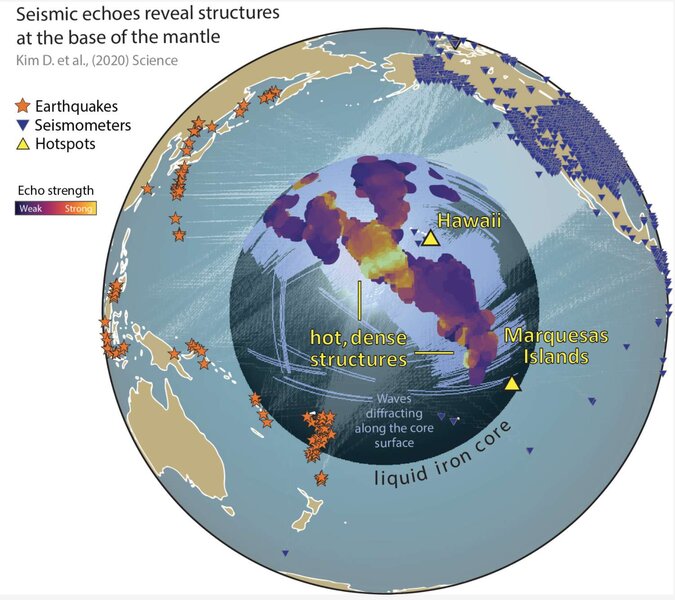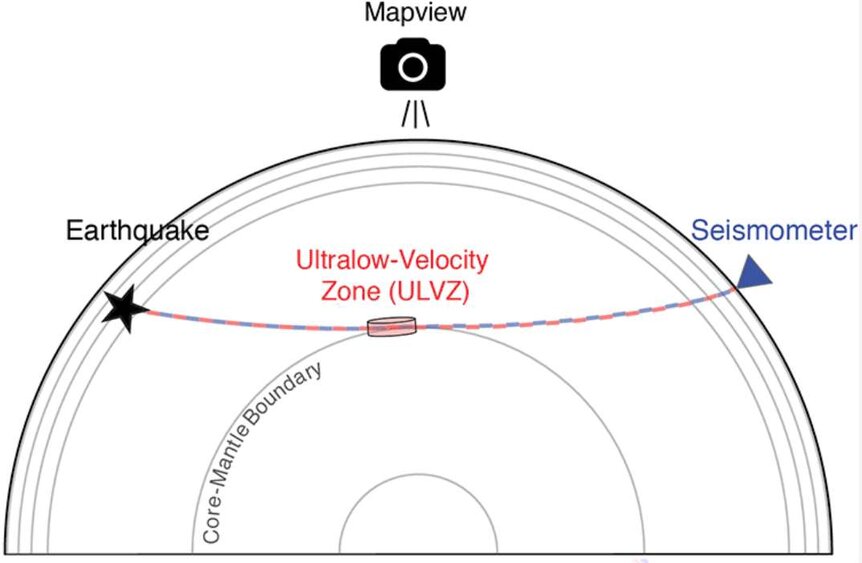Create a free profile to get unlimited access to exclusive videos, sweepstakes, and more!
Mysterious structures detected near Earth's core using bat-like echolocation

The vast region separating our planet's solid mantle and molten core is a mysterious realm mostly explored only in wild sci-fi fare like Jules Verne's 1864 novel Journey to the Center of the Earth or the slightly campy 2003 Hollywood feature film The Core.
Now a team of scientists from the University of Maryland targeting the echoes of seismic waves and how they travel under the Pacific Ocean basin have exposed some enlightening and unexplained structures inhabiting the zone deep beneath Earth's crust at the core-mantle boundary.
As outlined in a new study published June 12 in the online scientific journal Science, University of Maryland researchers replicated methods of echolocation similar to that used by bats and dolphins. Here they conducted the first simultaneous seismogram experiments using hundreds of earthquakes to identify reverberation signatures, detecting an unexpected number of widespread, clumped structures near the nickel-iron heart of the planet.
Those heterogenous areas of unusually dense, hot rock represent a massive shift in our understanding of what lies at the core-mantle border. Scientists are not yet certain of these structures' composition, and earlier studies have delivered only sparse views of them. The recent findings will provide for new theories of how plate tectonics worked in the development of the planet in its early eons, since that previous research has shown very few details of this inner-Earth zone.
"By looking at thousands of core-mantle boundary echoes at once, instead of focusing on a few at a time, as is usually done, we have gotten a totally new perspective," explained Doyeon Kim, a postdoctoral fellow in the UMD Department of Geology and lead author of the study. "This is showing us that the core-mantle boundary region has lots of structures that can produce these echoes, and that was something we didn't realize before because we only had a narrow view."
Geophysicists focused on the specific waveforms of seismic wave echoes traveling beneath the Pacific Ocean basin. Their analysis revealed previously unknown structures underneath the volcanic Marquesas Islands in the South Pacific.
Enlisting the help of a complex algorithm devised for studying stars and galaxies called the Sequencer, researchers called upon its ability to pore through large astronomical datasets looking for patterns after first recalibrating it to search through mountains of seismic data.
"Machine learning in earth science is growing rapidly and a method like Sequencer allows us to be able to systematically detect seismic echoes and get new insights into the structures at the base of the mantle, which have remained largely enigmatic," Kim notes.
After ingesting three decades of info encompassing nearly 7,000 seismograms of one distinctive type of seismic wave, Sequencer hunted down seismic echoes reflecting an ultra-low velocity zone that scientists might have glossed over in earlier analyses and discovered an eye-opening revelation.
As earthquake-generated seismic waves pulse into Earth's bowels thousands of miles below, these waves shift, slow, and scatter depending on variations in rock density, temperature, or composition. By calculating the travel time and intensity of these rebounding signals as they strike seismometers in different areas, scientists can create models of the physical properties of rock lurking below the surface.
"We were surprised to find such a big feature beneath the Marquesas Islands that we didn't even know existed before," explained geologist Vedran Lekić of the University of Maryland. "This is really exciting, because it shows how the Sequencer algorithm can help us to contextualize seismogram data across the globe in a way we couldn't before."
"We found echoes on about 40 percent of all seismic wave paths," Lekić added. "That was surprising because we were expecting them to be more rare, and what that means is the anomalous structures at the core-mantle boundary are much more widespread than previously thought."
After displaying Sequencer's aptitude for sniffing out unknown structures in this murky core-mantle territory, these techniques could be used further by applying different sorts of waves and frequencies to compose a high-resolution map of the Earth's interior, thus aiding geologists in their quest to better understand the evolution of Earth by examining these strange denser zones.





























